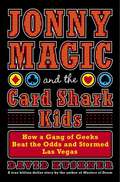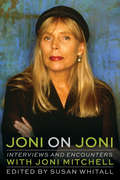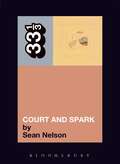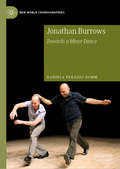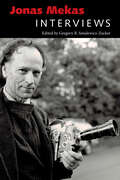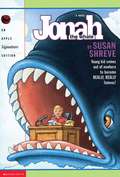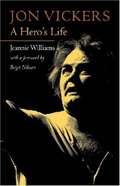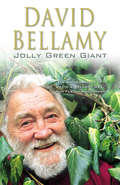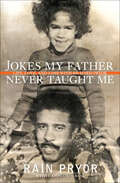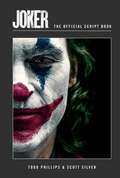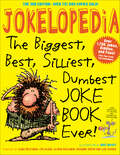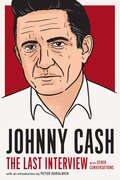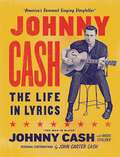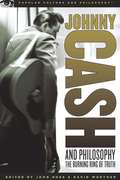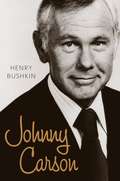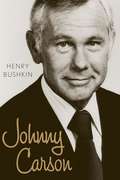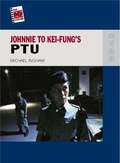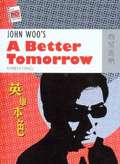- Table View
- List View
Jonny Magic and the Card Shark Kids
by David KushnerThe ultimate bully-magnet, Finkel grew up heckled and hazed until destiny came in the form of a trading-card game called Magic: The Gathering. Magic exploded from nerdy obsession to mainstream mania and made the teenage Finkel an ultracool world champion. Once transformed, this young shark stormed poker rooms from the underground clubs of New York City to the high-stakes tables online, until he landed on the largest card-counting blackjack team in the country. Taking Vegas for millions, Finkel’s squad of brainy gamers became the biggest players in town. Then they took on the town’s biggest game, the World Series of Poker, and walked away with more than $3.5 million. Thrilling, edgy, and ferociously feel-good, the odyssey of these underdogs-turned-overlords is the stuff of pop-culture legend. And David Kushner, acclaimed author of Masters of Doom, masterfully deals out the outrageous details while bringing to life a cast of characters rife with aces, kings, knaves . . . and more than a few jokers. If you secretly believe every player has his day, you’re right. Here’s the proof.
Joni on Joni: Interviews and Encounters with Joni Mitchell (Musicians in Their Own Words)
by Susan WhitallFew artists are as intriguing as Joni Mitchell. She was a solidly middle-class, buttoned-up bohemian; an anti-feminist who loved men but scorned free love; a female warrior taking on the male music establishment. She was both the party girl with torn stockings and the sensitive poet. <P><P> She often said she would be criticized for staying the same or changing, so why not take the less boring option? Her earthy, poetic lyrics (“the geese in chevron flight” in “Urge for Going”), the phrases that are now part of the culture (“They paved paradise, put up a parking lot”), and the unusual melodic intervals traced by that lissome voice earned her the status of a pop legend. Fearless experimentation ensured that she will also be seen as one of the most important musicians of the twentieth century. <P><P> Joni on Joni is an authoritative, chronologically arranged anthology of some of Mitchell’s most illuminating interviews, spanning the years 1966 to 2014. It includes revealing pieces from her early years in Canada and Detroit along with influential articles such as Cameron Crowe’s never-before-anthologized Rolling Stone piece. Interspersed throughout the book are key quotes from dozens of additional Q&As. Together, this material paints a revealing picture of the artist— bragging and scornful, philosophical and deep, but also a beguiling flirt.
Joni Mitchell's Court and Spark (33 1/3 Ser. #40)
by Sean NelsonIt’s a sucker bet to try and argue that Blue, or For 2 the Roses, or The Hissing of Summer Lawns are better or worse albums than Court and Spark, or than one another. In a certain way, they all feel like one sustained burst of musical endeavor from an artist who had only just begun to understand what she was capable of—and before she had decided to leave that strength behind in search of new powers. Still, Court and Spark is such a clear turning point, not just in terms of its popularity, but in terms of its approach. It represents a perfect example of an artist reaching out to a wide audience without pandering to it, in what feels, more than three decades on, like an honest attempt to say as much as possible to as many people as possible.
Jonathan Burrows: Towards a Minor Dance (New World Choreographies)
by Daniela Perazzo DommThe first monograph on the work of British choreographer Jonathan Burrows, this book examines his artistic practice and poetics as articulated through his choreographic works, his writings and his contributions to current performance debates. It considers the contexts, principles and modalities of his choreography, from his early pieces in the 1980s to his latest collaborative projects, providing detailed analyses of his dances and reflecting on his unique choreomusical partnership with composer Matteo Fargion.Known for its emphasis on gesture and humour, and characterised by compositional clarity and rhythmical patterns, Burrows’ artistic work takes the language of choreography to its limits and engages in a paradoxical, and hence transformative, relationship with dance’s historical and normative structures. Exploring the ways in which Burrows and Fargion’s poetics articulates movement, performative presence and the collaborative process in a ‘minor’ register, this study conceptualises the work as a politically compelling practice that destabilises major traditions from a minoritarian position.
Jonas Mekas: Interviews (Conversations with Filmmakers Series)
by Gregory R. Smulewicz-ZuckerA refugee from post–World War II Europe who immigrated to the US in 1949, Jonas Mekas (1922–2019) became one of America's foremost champions of independent cinema and one of its most innovative filmmakers. An admired poet in his native Lithuania, Mekas began recording his life on film shortly after his arrival in New York. Through his work as the author of the Village Voice’s “Movie Journal” column, editor of Film Culture magazine, and founder of Anthology Film Archives and the Film-Makers’ Cooperative, Mekas played a vital role in the promotion of avant-garde and independent films. His early films, Guns of the Trees and The Brig, challenged the structure of traditional narrative filmmaking. He is best known for his “diary films,” including Walden (Diaries, Notes, and Sketches); Reminiscences of a Journey to Lithuania; and As I Was Moving Ahead Occasionally I Saw Brief Glimpses of Beauty. His films, writings, and the institutions he built have influenced generations of filmmakers, poets, artists, musicians, critics, and scholars. In Jonas Mekas: Interviews, volume editor Gregory R. Smulewicz-Zucker collects eighteen interviews covering almost sixty years of the filmmaker’s career. Mekas discusses his remarkable life as a refugee from Nazi- and Soviet-occupied Lithuania, his role as one of the major figures in the development of the American avant-garde, and his thoughts about his own work. In conversation with scholars, journalists, and other prominent artists, Mekas speaks of his passion for artistic expression and uncompromising vision for a liberated cinema. These interviews preserve Mekas’s voice so that it might speak to future generations of artists and intellectuals.
Jonah the Whale
by Susan ShreveTo cope with the taunts of his schoolmates, lonely, overweight Jonah escapes into the fantasy of being a talk show host named "Jonah the Whale", and creates a new identity for himself.
Jon Vickers: A Hero's Life
by Jeannie WilliamsWith foreword by by Birgit Nilsson. During his extraordinary career, the now-legendary Canadian tenor Jon Vickers sang the most demanding of operatic roles -- Tristan, Peter Grimes, Otello, Aeneas, Parsifal -- with searing emotional intensity and dramatic interpretation. In this first biography of Vickers, Jeannie Williams provides a captivating and revealing portrait of a very private, deeply religious man and complex artist who baffled and often enraged his friends and colleagues. Drawing on scores of interviews with those who knew and worked with Vickers, Williams traces his life from boyhood in western Canada, to schooling in Toronto, to his debut at Covent Garden, to his tenure at the Royal Opera House, to his celebrated appearances on the world's major opera stages. She discusses his signature roles, including details of a little-known Otello in South Africa, over-the-edge performances, and stormy battles with conductors and directors. In addition, she details Vickers' controversial withdrawal from the Tannhuser opera, his on-going friction with BBC-TV, his conflicted relationship with his native Canada, and his choices in repertory. Williams also illuminates the paradoxes in the world view of a man who might have been a preacher or a prime minister if he had not been blessed with such a remarkable musical talent. This in-depth, well-balanced, and objective biography will stand as the definitive work on one of the world's greatest heroic tenors.
Jolson: The Legend Comes to Life
by Herbert G. GoldmanThey call him "The Immortal Jolson"--the dynamic king of Broadway. Audiences knew him for four decades as The World's Greatest Entertainer. Now Herbert G. Goldman gives us the definitive biography of this quintessential star of the musical stage. With a sure eye for the revealing anecdote, Goldman chronicles each step of Al Jolson's colorful life: his early struggles with his brother, Harry, on the vaudeville and burlesque circuit; his rise to stardom on Broadway, which prompted a Variety writer to proclaim, "The Shuberts may run the Winter Garden, but Al Jolson owns it;" his glory at the pinnacle of national fame, which came with his appearances in the movies The Jazz Singer (the first "talking picture") and The Singing Fool; his subsequent decline and brief resurgence after the film biography "The Jolson Story" was released in 1946; and his final round of appearances in 1950, entertaining American troops in Korea just before his death.
Jolly Green Giant
by David BellamyDavid Bellamy is a natural story teller whose memoir will be packed full of funny anecdotes and observations. It is the story of how a city boy, brought up in the middle of London, went for a trip into the countryside one day, an event which was to transform his life by setting in motion the amazing love of nature which would make famous this larger-than-life character. In his infectious style he illumines on, amongst other things, the fact that his father, the manager of a branch of Boots, had to grease his hair straight - because in those days managers of Boots weren't allowed to have curly hair! Then there was the time he and his brother discovered an exploded bomb, kept in the garden shed - and then accidentally blew off the front of the house with it. He reveals his secret passion is ballet dancing - and how his mother only found out about it when she saw him on stage at the Fairfield Hall in Croydon. His career as an academic, then author, broadcaster, consultant and television personality, spans 35 years and his main passion - campaigning for the environment - have led to many adventures including his being twice imprisoned in the Third World.
Jokes My Father Never Taught Me: Life, Love, and Loss with Richard Pryor
by Cathy Crimmins Rain PryorThe loving, witty, yet brutally honest memoir of the daughter of comedy legend Richard Pryor.Rain Pryor was born in the idealistic, free-love 1960s. Her mother was a Jewish go-go dancer who wanted a tribe of rainbow children. Rain’s father was Richard Pryor, perhaps the most compelling and brilliant comedian of his era, a man whose self-destructiveness was as legendary as his groundbreaking comedy.Jokes My Father Never Taught Me is an intimate, harrowing, poignant, and often hilarious memoir that explores the divided heritage and the forces that shaped a wildly schizophrenic childhood. It is the story of a girl who grew up adoring her father even as she feared him—and feared for him, as his drug problems got worse. Both lovingly told and painfully frank, it is an unprecedented look at the life of a comedy icon, told by a daughter who both understood the genius and knew the tortured man within.Praise for Jokes My Father Never Taught Me“Rain Pryor pulls no punches . . . Using the same profanity-laced wit her father perfected, she unspools darkly comic stories . . . but never devolves into self-pity or bitterness.” —Entertainment Weekly“Vital, entertaining and appalling, Pryor has fleshed out a familiar dysfunctional family refrain—”It was a lot easier to love him if you didn’t know him”—with bravery and wit.” —Publishers Weekly
Joker: The Official Script Book
by Insight EditionsRediscover Todd Phillips&’ Joker with this deluxe edition of the screenplay.Experience a cinematic origin story of the infamous DC villain as never before with this unique edition of the Academy Award-nominated Joker screenplay! Acclaimed and evocative, Joker depicts Arthur Fleck&’s descent into madness as a soulful, allegorical character study that belongs on the shelf of every Batman fan. • DISCOVER A UNIQUE VISION: By reading the screenplay, fans will gain insight into how screenwriters Todd Phillips and Scott Silver reimagined the Joker. • REEXPERIENCE A FILMMAKING TRIUMPH: Film stills give visual depth to this beloved screenplay.
Jokelopedia: The Biggest, Best, Silliest, Dumbest Joke Book Ever!
by Ilana Weitzman Eva BlankIt&’s the mother of all kids&’ joke books—an all-encompassing, gut-busting, and bestselling collection of more than 1,700 jokes, tongue-twisters, riddles, and puns for all occasions. Here are 61 elephant jokes, including: What did the elephant say when he walked into the post office? / Ouch! Dozens of knock-knock jokes, like: Knock-knock. / Who&’s there? / Doris. / Doris who? / Doris locked. That&’s why I knocked! Plus teacher jokes and creature jokes, doctor jokes and robber jokes, food jokes, gross jokes, why-did-the-chicken-cross-the-road jokes, and name-game jokes: What do you call a man in a tiger&’s cage? / Claude. And for all aspiring comedians, there are joke-telling pointers and tips, funny facts, and spotlights on comic TV shows, books, and actors, from Steve Carell to Tina Fey to SpongeBob Squarepants. It&’s the ultimate gift for the incurable jokester.
Jokelopedia: Athletic Antics Special Mini Edition
by Ilana Weitzman Eva Blank Alison Benjamin Rosanne GreenWhat's more fun than telling a good joke? Jokelopedia - "the mother of all joke books!" - will give kids one-liners that will make them the funniest kid at home, around the neighborhood and in class. Spending time laughing together is a great way to teach kids the value of Having Fun with family and friends. Let the laughs begin!
Joke-Performance in Africa: Mode, Media and Meaning (Routledge Contemporary Africa)
by Ignatius ChukwumahJokes have always been part of African culture, but never have they been so blended with the strains and gains of the contemporary African world as today. Joke-Performance in Africa describes and analyses the diverse aesthetics, forms, and media of jokes and their performance and shows how African jokes embody the anxieties of the time and space in which they are enacted. The book considers the pervasive phenomenon of jokes and their performance across Africa in such forms as local jests, street jokes, cartoons, mchongoano, ewhe-eje, stand-up comedy, internet sex jokes, and ‘comicast’ transmitted via modern technology media such as the TV, CDs, DVDs, the internet platforms of YouTube, Facebook, and other social arenas, as well as live performances. Countries represented are Egypt, Kenya, Malawi, Morocco, Nigeria, and Zambia, covering the North, West, East and Southern Africa. The book explores the description of the joke form from various perspectives, ranging from critical discourse analysis, interviews, humour theories, psychoanalysis, the postcolony and technauriture, to the interactive dramaturgy of joke-performances, irrespective of media and modes of performance. Containing insightful contributions from leading African scholars, the book acquaints readers with detailed descriptions of the diverse aesthetics of contemporary African jokes, thereby contributing to the current understanding of joke-performance in Africa. It will appeal to students and scholars of African studies, popular culture, theatre, performance studies and literary studies.
Jojo: Finally Home - My Inspirational Memoir - THE SUNDAY TIMES BESTSELLER (2023)
by Johannes RadebeChampion dancer and Strictly Come Dancing professional Johannes Radebe has captured our hearts with his mesmerising talent, bringing joy to millions of fans and wowing the most critical of judges. He is loved not only for his dancing, but for his beautiful, infectious spirit and energy.Jojo: Finally Home is his never-before-told story, where he shares the experiences and challenges he's faced - from growing up in Zamdela, a township in South Africa, as a young boy with a passion for dance (and playing with Barbies), to becoming the star he is today. Dance transformed Jojo's future, giving him a tool to express himself - but as you will learn, this was not always easy.Captivating and moving, these are Jojo's tales of euphoric highs and all-time lows, of making history, of grief, love, family and opportunity. It is a celebration of him finally feeling at home in his own skin. These are the personal moments that have shaped him into the man he is today - someone who lives life to the full and believes that no mountain is insurmountable.(P)2023 Hodder & Stoughton Limited
Jojo: Finally Home - My Inspirational Memoir - THE SUNDAY TIMES BESTSELLER (2023)
by Johannes Radebe*THE INSTANT SUNDAY TIMES BESTSELLER!*Champion dancer and Strictly Come Dancing professional Johannes Radebe has captured our hearts with his mesmerising talent, bringing joy to millions of fans and wowing the most critical of judges. He is loved not only for his dancing, but for his beautiful, infectious spirit and energy.Jojo: Finally Home is his never-before-told story, where he shares the experiences and challenges he's faced - from growing up in Zamdela, a township in South Africa, as a young boy with a passion for dance (and playing with Barbies), to becoming the star he is today. Dance transformed Jojo's future, giving him a tool to express himself - but as you will learn, this was not always easy.Captivating and moving, these are Jojo's tales of euphoric highs and all-time lows, of making history, of grief, love, family and opportunity. It is a celebration of him finally feeling at home in his own skin. These are the personal moments that have shaped him into the man he is today - someone who lives life to the full and believes that no mountain is insurmountable.
Jojo: Finally Home - My Inspirational Memoir - THE SUNDAY TIMES BESTSELLER (2023)
by Johannes Radebe*THE INSTANT SUNDAY TIMES BESTSELLER!*Champion dancer and Strictly Come Dancing professional Johannes Radebe has captured our hearts with his mesmerising talent, bringing joy to millions of fans and wowing the most critical of judges. He is loved not only for his dancing, but for his beautiful, infectious spirit and energy.Jojo: Finally Home is his never-before-told story, where he shares the experiences and challenges he's faced - from growing up in Zamdela, a township in South Africa, as a young boy with a passion for dance (and playing with Barbies), to becoming the star he is today. Dance transformed Jojo's future, giving him a tool to express himself - but as you will learn, this was not always easy.Captivating and moving, these are Jojo's tales of euphoric highs and all-time lows, of making history, of grief, love, family and opportunity. It is a celebration of him finally feeling at home in his own skin. These are the personal moments that have shaped him into the man he is today - someone who lives life to the full and believes that no mountain is insurmountable.
Johnny Cash: and Other Conversations (The Last Interview Series)
by Johnny CashJohnny Cash seemed like the stuff of legend when he was alive, and even more so as he achieved something close to sainthood in death. The interviews collected here bring us closer to the actual man: brilliant, falliable, introspective, and longing for redemption.Mythmaker, philosopher, sinner, and saint, Johnny Cash is perhaps the quintessential American icon. Though often rebellious and unruly, he rarely spoke without intention, sincerity, and a bit of poetry. Together with an introduction by music critic Peter Guralnick, the interviews here spotlight that inimitable rhetorical style, and the fascinating diversity of subjects that made him as relatable as he was mysterious. From a hopped up early interview with Pete Seeger, to a meditation on sobriety, to the last interview in which he stares calmly into the face of death, this collection brings together decades of insight as deeply profound as the unforgettable baritone of The Man in Black himself.
Johnny Cash: The Life In Lyrics
by Johnny CashThe life of the Man in Black revealed by his lyrics and by rare photographs and ephemera, in a collectible edition featuring 125 of his most iconic songs, authorized by the Cash estate Johnny Cash is one of the most beloved and influential country-music stars of all time, having composed more than six hundred songs and sold more than ninety million records. He received twenty-nine gold, platinum, and multiplatinum awards for his recordings and has been inducted into the Grammy Hall of Fame, the Rock & Roll Hall of Fame, the Country Music Hall of Fame, and the Hollywood Walk of Fame. This is the first time Cash&’s fifty years of songwriting have been collected anywhere; this book includes the lyrics to 125 songs and the stories behind them. Perhaps more than any other American artist, he spoke to the soul of the nation as well as to the triumphs and challenges of his own life. These pages explore Cash's range as a poet and storyteller, taking readers from his early life and first successes through periods of personal challenge, activism, and faith. The result is a profound understanding of Johnny Cash as a man and an artist, as well as the American story he helped shape. An essential collectible that sheds new light on Cash&’s life and work, this book includes rare visual material in addition to remembrances from Cash&’s son, John Carter Cash, &“family historian&” Mark Stielper. Released for the twentieth anniversary of the legendary musician&’s passing, it will be a landmark in music publishing
Johnny Cash and Philosophy: The Burning Ring of Truth
by John Huss David WertherIn Johnny Cash and Philosophy, twenty-one philosophers explore the implications of the Johnny Cash myth and the Johnny Cash message. Their investigations uncover the distinctive relevance of Johnny Cash for moral responsibility, social justice, patriotism, romantic love, artistic creativity, class oppression, and individual identity.
Johnny Carson
by Henry BushkinFrom 1962 until 1992, Johnny Carson hosted The Tonight Show and permeated the American consciousness. In the ’70s and ’80s he was the country’s highest-paid entertainer and its most enigmatic. He was notoriously inscrutable, as mercurial (and sometimes cruel) off-camera as he was charming and hilarious onstage. During the apex of his reign, Carson’s longtime lawyer and best friend was Henry Bushkin, who now shows us Johnny Carson with a breathtaking clarity and depth that nobody else could. From the moment in 1970 when Carson hired Bushkin (who was just twenty-seven) until the moment eighteen years later when they parted ways, the author witnessed and often took part in a string of escapades that still retain their power to surprise and fascinate us. One of Bushkin’s first assignments was helping Carson break into a posh Manhattan apartment to gather evidence of his wife’s infidelity. More than once, Bushkin helped his client avoid entanglements with the mob. Of course, Carson’s adventures weren't all so sordid. He hosted Ronald Reagan’s inaugural concert as a favor to the new president, and he prevented a drunken Dean Martin from appearing onstage that evening. Carson socialized with Frank Sinatra, Jack Lemmon, Jimmy Stewart, Kirk Douglas, and dozens of other boldface names who populate this atmospheric and propulsive chronicle of the King of Late Night and his world. But this memoir isn't just dishy. It is a tautly rendered and remarkably nuanced portrait of Carson, revealing not only how he truly was, but why. Bushkin explains why Carson, a voracious (and very talented) womanizer, felt he always had to be married; why he loathed small talk even as he excelled at it; why he couldn't visit his son in the hospital and wouldn't attend his mother’s funeral; and much more. Bushkin’s account is by turns shocking, poignant, and uproarious — written with a novelist’s eye for detail, a screenwriter’s ear for dialogue, and a knack for comic timing that Carson himself would relish. Johnny Carson unveils not only the hidden Carson, but also the raucous, star-studded world he ruled.
Johnny Carson
by Henry BushkinA revealing and incisive account of the King of Late Night at the height of his fame and power, by his lawyer, wingman, fixer, and closest confidantFrom 1962 until 1992, Johnny Carson hosted The Tonight Show and permeated the American consciousness. In the '70s and '80s he was the country's highest-paid entertainer and its most enigmatic. He was notoriously inscrutable, as mercurial (and sometimes cruel) off-camera as he was charming and hilarious onstage. During the apex of his reign, Carson's longtime lawyer and best friend was Henry Bushkin, who now shows us Johnny Carson with a breathtaking clarity and depth that nobody else could.From the moment in 1970 when Carson hired Bushkin (who was just twenty-seven) until the moment eighteen years later when they parted ways, the author witnessed and often took part in a string of escapades that still retain their power to surprise and fascinate us. One of Bushkin's first assignments was helping Carson break into a posh Manhattan apartment to gather evidence of his wife's infidelity. More than once, Bushkin helped his client avoid entanglements with the mob. Of course, Carson's adventures weren't all so sordid. He hosted Ronald Reagan's inaugural concert as a favor to the new president, and he prevented a drunken Dean Martin from appearing onstage that evening. Carson socialized with Frank Sinatra, Jack Lemmon, Jimmy Stewart, Kirk Douglas, and dozens of other boldface names who populate this atmospheric and propulsive chronicle of the King of Late Night and his world.But this memoir isn't just dishy. It is a tautly rendered and remarkably nuanced portrait of Carson, revealing not only how he truly was, but why. Bushkin explains why Carson, a voracious (and very talented) womanizer, felt he always had to be married; why he loathed small talk even as he excelled at it; why he couldn't visit his son in the hospital and wouldn't attend his mother's funeral; and much more. Bushkin's account is by turns shocking, poignant, and uproarious -- written with a novelist's eye for detail, a screenwriter's ear for dialogue, and a knack for comic timing that Carson himself would relish. Johnny Carson unveils not only the hidden Carson, but also the raucous, star-studded world he ruled.
Johnnie To Kei-Fung's PTU
by Michael InghamPTU is an underappreciated noir masterpiece by one of Hong Kong's most prolific and commercially successful directors. Johnnie To Kei-fung has been called "the poet of post-1997 and the economic savior of the Hong Kong film industry" for an extraordinary range of films produced during some of Hong Kong cinema's most difficult years. While many of To's celebrated films such as Election, Exiled and The Mission feature themes of criminal glory and revenge, PTU centers on the ethical dilemmas, personal dramas and stoic teamwork in the elite Police Tactical Unit. The story follows the PTU's all-night search for an officer's missing gun as they navigate triad turf struggles and marauding jewel thieves from mainland China. Shot over several years in the hauntingly empty pre-dawn streets of Tsim Sha Tsui, and released coincidentally amid the 2003 SARS panic, the film evokes Hong Kong's post-handover economic despair and multiple identity crises. In terms of character development and psychological complexity, Mike Ingham argues that PTU is the most aesthetically rigorous and satisfying of To's many films.
John Woo's A Better Tomorrow
by Karen Fang'A Better Tomorrow' has always been hailed as a milestone in Hong Kong cinema. This book describes the different responses to the movie in Hong Kong and later in its reception worldwide, which paved the way for the promotion of John Woo and Chow Yun-fat to their current prominence in Hollywood. Fang examines the different notions of the genre of action cinema in Asian and Western film industries. She tracks the connections between ying shung pian, or "hero" movie, the term by which Woo's film became famous in Hong Kong, and the spectacle of violence emphasized in the term "heroic bloodshed," the category in which the film was known in the West. Finally, she concludes with a discussion of the status of the film and its huge success in the current globalized industry.
